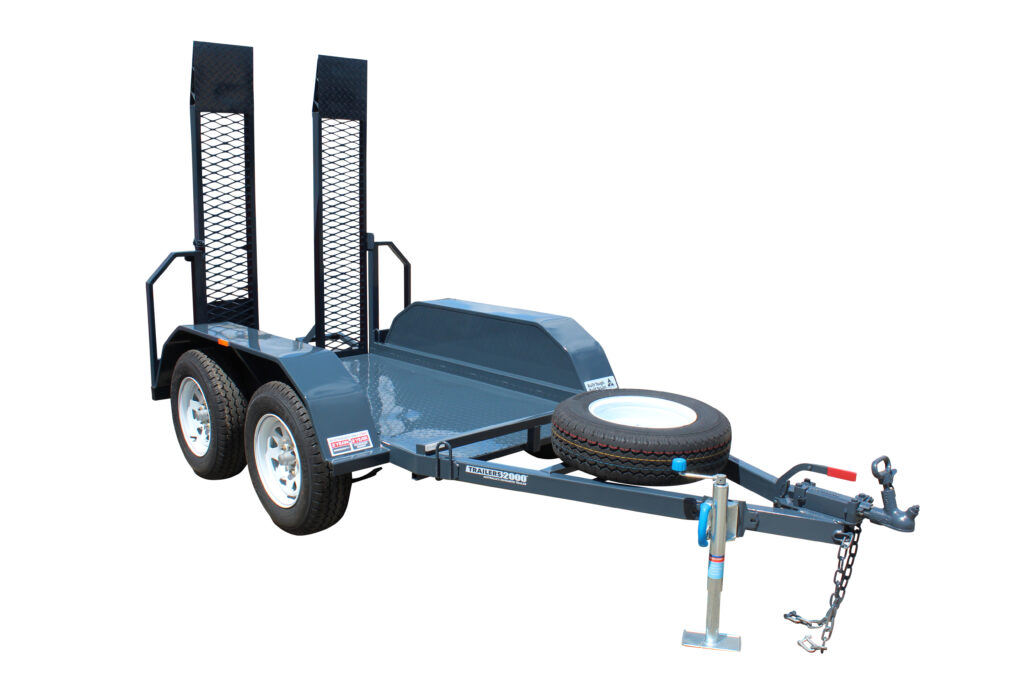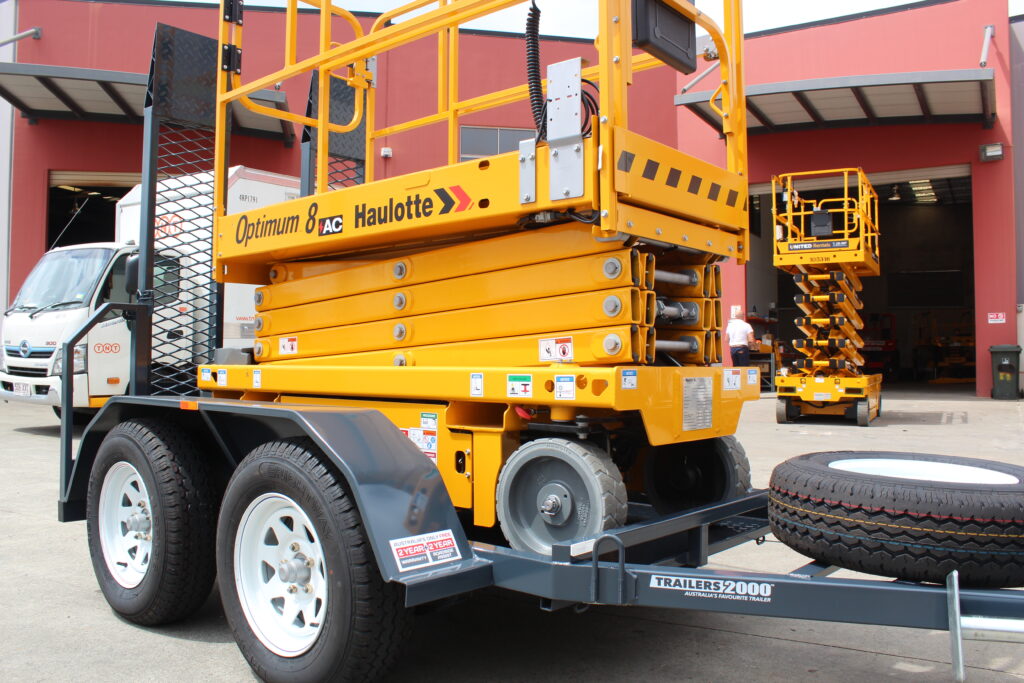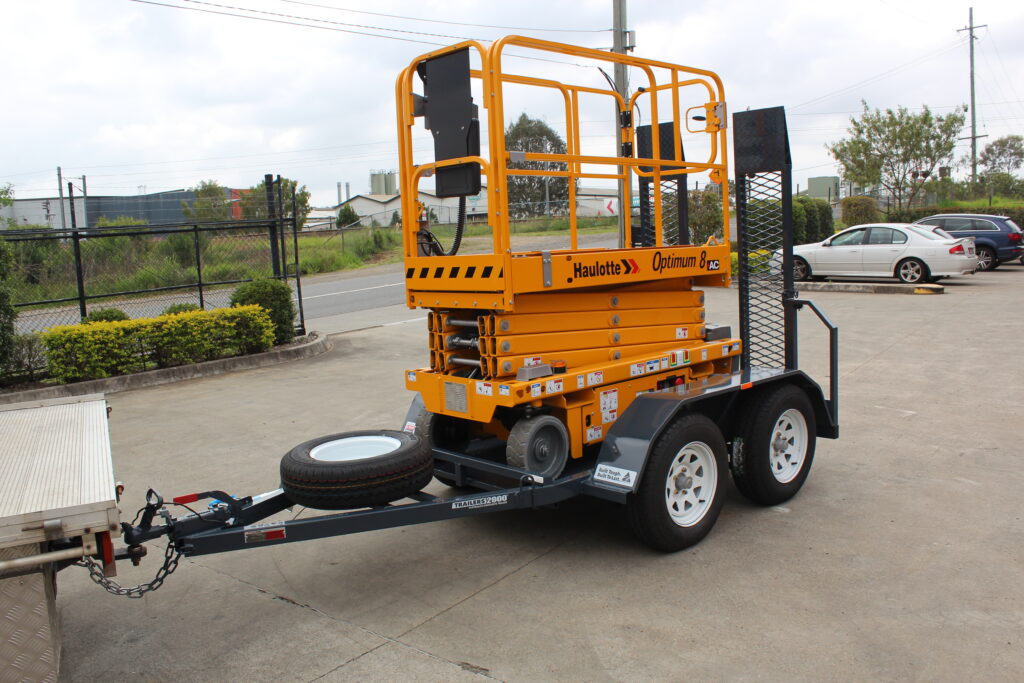Construction lifts are a vital aspect of any construction operation. With bucket trucks, articulated boom lifts, telescopic forklifts, telescopic boom lifts, and scissor lifts, construction workers can achieve more in a shorter time. Of all these, the scissor lift is perhaps the most common in any construction site. Scissor lifts can help move materials around the construction site, and workers can safely reach certain heights without complicated scaffolding.
There are a couple of scenarios where you need to either transport your forklift between sites or move them to a new location. Although scissor lifts are equipped with non-marking tyres, you’ll probably need a scissor lift trailer to move them around. We’ll look at the proper and safe ways to transport them, but first, what are scissor lifts?

What Is A Scissor Lift?
A scissor lift is a machine fitted with a platform to elevate construction loads, workers, and their tools in a vertical direction to higher areas. Scissor lifts are common in facility maintenance and construction areas, and can lift workers anywhere from 5.9 to 17.9 m. Otherwise known as slab scissors, these machines are designed for use on concrete slab surfaces.
Considering the fact that a scissor lift can elevate multiple workers and their tools simultaneously, they are an affordable and logical option for most construction projects. Moreover, they are a great alternative to ladders, towers, and scaffolds. Scissor lifts come in different applications, sizes, and fuel types. The most common types include:
- Pneumatic scissor lifts
- Rough terrain scissor lifts
- Electric scissor lifts
- Hydraulic scissor lifts
- Diesel scissor lifts.
What Is A Scissor Lift Used For?
Scissor lifts can be used in a wide variety of applications and industries. With one, the safety and efficiency of your work can be vastly improved. Small businesses and giant corporate bodies alike can benefit from having a scissor lift around.
- Construction / Building Maintenance
A scissor lift serves as a portable and versatile solution to construction projects. Whether you’re renovating or building from scratch, a scissor lift can come in handy. On the other hand, if you need to work high in the air while hanging banners, pouring concrete, hanging lights, laying bricks, or changing signs, a scissor lift is extremely useful. You might also need a construction trailer at your site.
- Delivery / Production
Scissor lifts see a lot of work in busy shipping yards and manufacturing plants. They can help workers move loads that are too heavy or reach certain heights. With this platform, you can get things done faster, whether it’s a food processing, brick-laying, chemical processing, or manufacturing plant.
- Warehousing / Retail
Wherever storage is involved, every horizontal and vertical space must be used efficiently. A scissor lift makes stacking and unloading easier and faster, especially when the shelves are tall.
Other uses for scissor lifts include:
- Changing overhead signs
- Property management
- Transportation management
- Landscaping
- Electrical work
- Painting, etc.
How To Transport a Scissor Lift
If you run a scissor lift hire company or own a scissor lift as a contractor, you definitely know how important these machines are. However, what happens when you need to move your scissor lift from place to place? Most people go the route of hiring towing agencies or using a tilt tray truck when they need to move their scissor lift from one site to another.
While that serves the purpose in the short term, it is more expensive over time and comes with its set of risks. A trailer is your best bet when transporting scissor lifts, but you can’t use just any trailer for this. For example, hydraulic tipping trailers, tradesman trailers, or luggage trailers are not great options for transporting your scissor lifts. A better solution would be getting your own scissor lift trailer.
What Is A Scissor Lift Trailer?
A scissor lift trailer is designed to transport scissor lifts and other similar equipment from site to site. Although they are a bit similar to car trailers, mining trailers, and plant trailers, a scissor lift trailer has just enough space to fit a scissor lift while towing.

Benefits of Scissor Lift Trailers
When it comes to transporting your scissor lifts, the safety of the equipment should be your priority. And nothing assures you of that safety better than a scissor lift trailer.
At Trailers 2000, we specialise in building durable trailers that can withstand the toughest Australian conditions. Some benefits of our scissor lift trailers include:
- Built-in ramps that allow easy loading and unloading of scissor lifts
- Our scissor lift trailers are built lower to the ground to make loading easier
- All scissor lift trailers come with corrosion-resistant galvanised steel chassis, slipper suspension, heavy-duty fold down ramps, solid steel drop axles and brand new 14″ wheels and light truck tyres.
- Our scissor lift trailers can come in a variety of aggregate trailer masses ranging from 2000 kg, 2490 kg, 3000 kg, 3500 kg, and 4500 kg ATM.
- Additionally, a stop bar at the front of the trailer allows the scissor lift to be parked in an optimal position for even weight distribution. There are also tie-down points on the scissor lift trailer that help you secure the scissor lift to the trailer.

The best part is that Trailers 2000 can help you customise your trailers to fit certain requirements. Perhaps you need an enclosed scissor lift trailer, braking on all wheels, lighting equipment, or accessories like a toolbox; we are up to the task and can work with you to design the scissor lift trailer of your dreams. Speak to our experts to learn about different customisation options.
Trailers 2000 specialises in building quality trailers that guarantee reliability and value while offering you lots of options. Our scissor lift trailers are reliable, sturdy, and built to last. Browse our scissor lift trailers, or contact us to learn more about our offerings.
